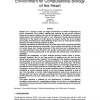Free Online Productivity Tools
i2Speak
i2Symbol
i2OCR
iTex2Img
iWeb2Print
iWeb2Shot
i2Type
iPdf2Split
iPdf2Merge
i2Bopomofo
i2Arabic
i2Style
i2Image
i2PDF
iLatex2Rtf
Sci2ools
BCS
2008
2008
Beatbox - A Computer Simulation Environment for Computational Biology of the Heart
Despite over a century's study, the trigger mechanisms of cardiac arrhythmias are poorly understood. Even modern experimental methods do not provide sufficient temporal and spacial resolution to trace the development of fibrillation in samples of cardiac tissue, not to mention the heart in vivo. Advances in human genetics provide information on the impact of certain genes on cellular activity, but do not explain the resultant mechanisms by which fibrillation arises. Thus, for some genetic cardiac diseases, the first presenting symptom is death. Computer simulations of electrical activity in cardiac tissue offer increasingly detailed insight into these phenomena, providing a view of cellular-level activity on the scale of a whole tissue wall. Already, advances in this field have led to developments in our understanding of heart fibrillation and sudden cardiac death and their impact is expected to increase significantly as we approach the ultimate goal of whole-heart modelling. Mod...
| Added | 29 Oct 2010 |
| Updated | 29 Oct 2010 |
| Type | Conference |
| Year | 2008 |
| Where | BCS |
| Authors | Ross McFarlane, Irina V. Biktasheva |
Comments (0)

